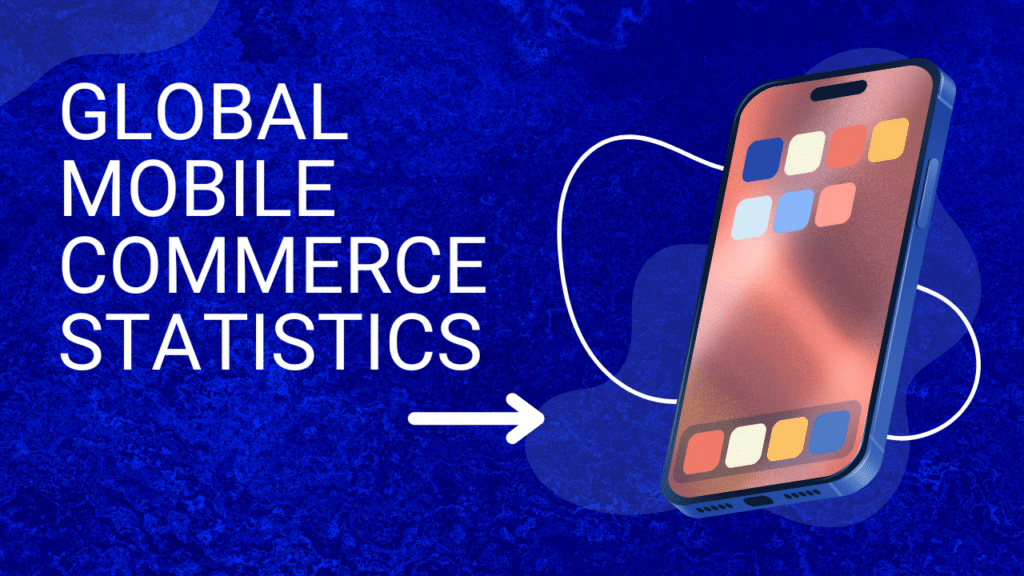We, marketers, keep our eyes glued on analytics dashboard and crunch numbers all day long inside our heads, so we get a bit obsessed with numbers. And it’s a good thing.
However, we don’t do business with pixels on our screen. We do business with our audience. Real people.
They are just like you and me. They have their own emotions, desires, and quirks.
If you want to increase your conversion, you have to inspire them to take the action you want them to do.
For that, you need to peep into their minds and get their compliance.
Want to know how?
Let’s dive in.
What is compliance gaining in marketing?
We all do illogical things. We buy fancy stuff we don’t need. We smoke cigarettes even after knowing how bad it is. We binge watch Netflix for hours.
Why?
Because those ‘bad decisions’ feels good, even exciting. As much as we all want to call ourselves “rational”, emotions influence our decisions.
Compliance gaining techniques, simply put, is a set of techniques designed to appeal to that emotional side to inspire actions. From a marketers perspective, compliance gaining techniques ensure your potential buyers do what you want them to do.

Now, it might sound manipulative to some. But let me assure you, it is not. For example, entire content marketing is built on reciprocity. The idea is, to make sales you need to educate your buyers first. That’s an instance of compliance gaining at its full glory.
Why you want to use compliance gaining for higher conversion
Suppose you want to buy a subscription for your favorite magazine. There are three pricing options available:
- Online Subscription $59
- Print subscription $125
- Online + print subscription $125
Print subscription and online plus print subscription would cost the same.
Crazy, right? The middle option makes no sense.
Dan Ariely thought the same when he saw The Economist’s pricing. He conducted a study with 100 MIT students. Initially, 84 students picked option C, 16 students preferred option A and none picked option B. So Ariely removed that “useless” option B in the next phase of the experiment. However, this time students preferred the cheaper option: option A.
Turns out, option B was there to make the expensive option C looks profitable. People compared option C with B and spent $125.
That’s the power of subtle compliance gaining. You can influence their behavior and they wouldn’t have a clue.

The application of psychology in sales isn’t new. However, in 2019 knowing how to use psychology is a must. Because the competition is cutthroat. A consumer now gets bombarded with 5000 marketing messages every day, each fighting tooth and nail for consumer’s attention. The attention span of the average human now has also reduced to 8 sec, even shorter than a goldfish’s.
In order to increase your conversion, you must have the knowledge of compliance gaining principals. But you don’t know where to start from? Well, we’ll get you covered in the next section.
The following sections will discuss different compliance gaining techniques that you can apply to your marketing campaigns to generate higher conversions.
Foot-in-the -door
One of the pillars of the human mind is consistency. Consistency is the reason people stay in the same boring job or stick to particular brands even when quality is diminishing.
The foot-in-the-door technique exploits the human need of being consistent. The basic principle is, you ask for a small favor from buyers. So small that they would comply. Later ask them for a bigger favor. Chances are good they would likely to co-operate again.
In 1966, Jonathan Freedman and Scott Fraser conducted an experiment that proves the potential of Foot-in the-door technique.

Researchers randomly picked 156 women and separated them into two groups. The first group was asked about the household products they use (the small request). Later, researchers made a big request to the same group: to allow a group of strangers in their home. Whooping 52.8% agreed.
The second group was approached with the big request right off the bat. Only 22.2% of the entire group said yes.
The application of FITD is quite common in CRO. Many marketers subtly slip FITD in UI and content for better conversion. One of such examples is Godaddy’s pricing page.
Whenever a user purchases a domain name (small request) Godaddy presents other optional services(slightly bigger request) step by step.
At first, the user sees other domain names he can buy.

Once the user moves on to the next page, they are shown pricier services like hosting and email (bigger requests).
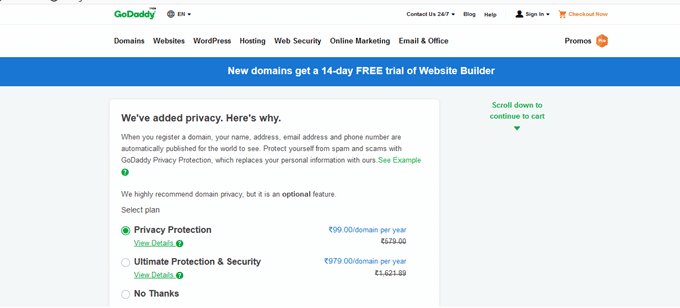
The best part is, Godaddy doesn’t come across sale-y. Users can refuse all of those additional services. However, persuasive copywriting does a good job of keeping the user hooked.
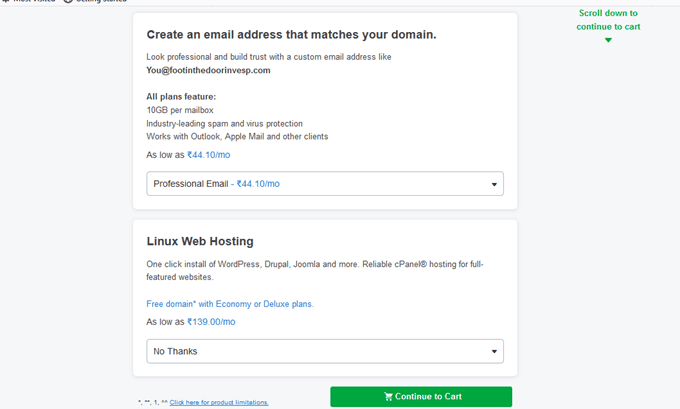
Door-in-the-face
Ever bargained in a local market?
It usually goes like this: Shopkeeper usually tells you a price. You shake your head in disagreement and offer your own price. After some back and forth, you both agree on a price that is lesser than what he quoted and higher than your initial bid.
Chances are good you didn’t pay attention earlier but you were under the spell of another widely used compliance gaining method: Door-in-the-face (DITF).
DITF is the exact opposite of FITD. Here, you ask for the bigger request first which acts as an anchor or frame of reference. Once you get rejected, you immediately ask for a smaller request. Many people feel a social burden whenever they flat out reject a request. Accepting the smaller request gets rid of that burden. Thus they accept your request.
One of the noted researches on the DITF technique is done by Robert Cladini ( Author of the famous book “Influence”). His team asked university students to invest two hours a week for two years for a boring irrelevant task. Most of the students refused. Later when researchers asked for just “one day”, 50% of students said “yes”.
DITF is a century-old persuasive technique that has been used in both offline and online marketing. In conversion optimization DITF often is used along with other influencing techniques like social proof and anchoring.
Bluehost uses DITF principles in a very under-the-radar way.
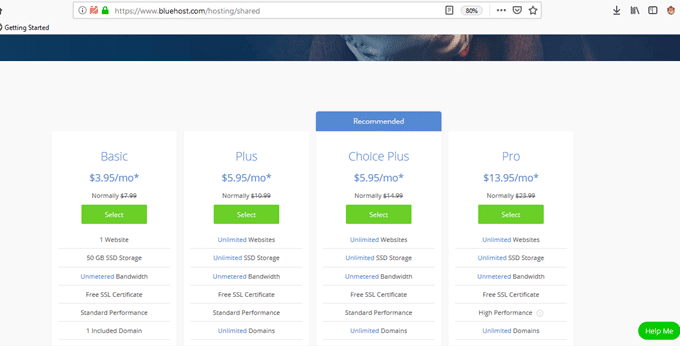
Take a look at these plans. Why do you think they even mentioned the “normal” price ( which is higher than the actual price)? Those higher prices act as “big requests” and current prices come off as “smaller requests”. Bluehost has been sticking to the same pricing page design for quite some time. Clearly, the DITF technique is working for them.
Ingratiation
We have been told that opposite attracts. And Hollywood tried its best to reinforce that belief again and again. From Beauty and the Beast to Anne Hall, two completely different individuals always end up together.
In reality, however, it’s the other way around. We, humans, are comfortable with familiarity. It’s not just speculation. This recent study supports the theory that individuals with similar personalities tend to be friends or romantic partners.
Ingratiation utilizes the principle of familiarity. Edward E Jones, a psychologist who studied ingratiation back in 1964, concluded people get persuaded by someone they can relate to and like.
In other words, if you can make your buyers like you, they would like to do business with you. And the best way to make others like you is by highlighting the similarities.
Ingratiation technique isn’t uncommon in CRO. Conversion experts use copywriting and design elements to make the brands more relatable. But only a very few those brands managed to unlock the full potential of ingratiation.
PetRelocation is one of them.
PetRelocations is a pet shipping service. They understand their customers would like someone with their own pets. That’s why Petrelocation’s team page share details about each employee’s own pets and their images.
Take a look at their team page:

Pique technique
For any marketer getting buyers’ attention is a big challenge. Buyers are often on autopilot and develop certain “resistance” thanks to the endless marketing messages they are exposed to.
That means, no matter how great your offering is, unless you break their autopilot mode, you are going nowhere.
Pique technique is unrivaled when it comes to drawing the attention. The underlying principle is pretty straight forward: first, you say something unusual. Something that piques interest among others. Once they are hooked you fire your original request. Here is an example:

Scientific studies proved that the pique technique is very effective for one-time compliance gaining like seeking donations or newsletter sign-ups. The pique technique works as good even if you have more than two requests to make. Asking for odd amounts as donations also slightly increase the conversion rate. For example, you ask for $7, $29 and $41 instead of conventional amounts ending with a 0 or 5 like $ 5 or $ 25.
Interestingly, if you craft your message well, people are willing to pay well beyond your average price. For example, Make a Wish, a Canadian foundation had several donate options— $25, $90, $100, $250, $1000 and $6518. They found out every now and then some donors are willing to spend over $6k.
The Sightsavers donations page is a perfect example of how to use the pique technique for conversion optimization. They use multiple donation options. Each donation option comes with an emotionally appealing request attached.

Reciprocity
Have you ever found yourself doing something extra, even outside of the contract for a client who asks about your children and pays for your lunch when you two meet?
Congrats! You have been seduced by the principle of reciprocity. In your defense, we all are hardwired to do favors to the person who did something nice for us. Reciprocity exploits this emotional “programming” of human nature.
Robert Cladini, in his book “Influence”, included reciprocity as one of the six pillars of effective persuasion. Reciprocity is so powerful because it comes with a burden of future expectations or indebtedness. People want to get rid of the burden by being more accommodating.
Results?
Small inexpensive gestures of gratitude can spike in revenue significantly. In 2002, researchers did an experiment where servers offered free candy after guests finished their dinners. Turns out the number of tips those servers received went up 18% when one candy is offered and 22% for two candy.
Another perk of using reciprocity, especially when you offer free knowledge, it makes you trusted. Your buyers start viewing your brand as an authority and do business with you.
Hubspot’s learning center is a perfect example of application reciprocity. They offer completely free marketing courses which are extremely in-depth and on par with any paid courses out there.

The entire concept of content marketing is built upon the principle of reciprocity. And very few brands do content marketing better than Copyblogger. They understand their audience inside out and always publish super relevant yet free content.

Authority
Think about it.
How would you feel if a cop in his uniform walk behind you and ask you stop doing whatever you are doing? You would probably oblige him immediately.
Now if a regular person asks you to stop? Would you drop everything like before? Or just turn you back, look him in the eye and ask him “why”?
You would be far more accommodating because of that uniform, right?
That’s the power of authority. People are far easier to persuade when the message comes from an authority figure.
Marketers know this. And the usage of authority in marketing is widespread. Here is an old ad for a cigarette company promoting smoking using doctors’ authoritative appeal. Unethical? Yes. Effective? Yes, again.

Image Source: Ethic
There are three ways to use the authority principle in your web copy for higher conversion. First, you get a lot of social proof and become a thought leader yourself. This is a harder and more rewarding route. Tim Ferris himself nails this.

Alternatively, you can get your name associated with other authorities and leaders and become authority through osmosis. Last and the best way is the combination of the previous two. Jeff Bullas is an example you can follow.
Here is a screenshot from his site.
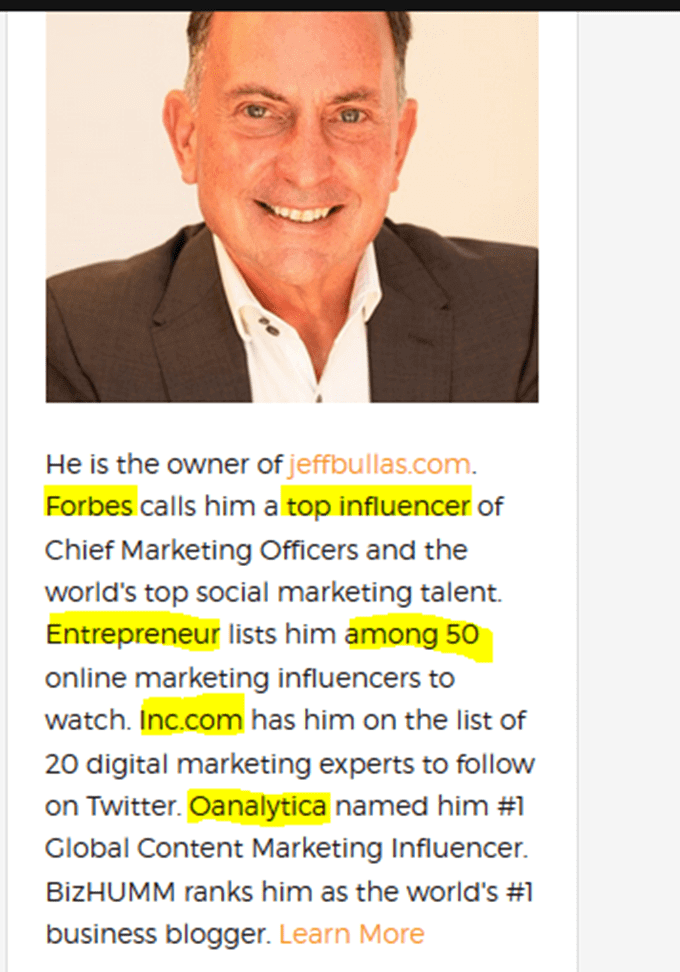
Apart from being an authority in his own right, Jeff showcases how other authoritative figures have recognized his expertise.
Now it may not be possible for you to get recognized by Forbes or the Inc. right off the bat. However, you can always display the list of the prestigious industry sites you have featured on and reap some authority points.
Disrupt and reframe
Disrupt and reframe is an excellent technique for stopping others’ trains of thought in the track and compelling them to make a decision.
It starts from a very outlandish or even infuriating statement that throws the readers off. Immediately speaker reframes the statement before the listener’s logical sense comes back. Since the listener’s mind is distracted he just accepts the reframed suggestions. In a nutshell D&R this all about creating an opening for planting a seed of thought on the listener’s mind.
This is an effective application NLP pattern break. DTR techniques have been tested in 14 different studies with hundreds of participants.
it’s surprisingly effective in sales, charity donations even altering people’s attitudes. Even more effective than other compliance gaining techniques like affirming autonomy.
Here is something interesting. The disruptions used can be childish sometimes. For example, in one study researchers used “money some” instead of “some money”. Makes no sense, right? That is the point. You want distractions to sound or look confusing but not complete gibberish.
Now D&R sounds a lot like pique technique but these two are different. The pique technique is based on unconventional, attention-grabbing statements or questions. D&R is more subtle. Sometimes a specific word or body language cue can serve as a distraction.
Implementing D&R on web copy isn’t easy. That being said, some brands like Apple have made it a part of their copywriting process.
Here is an excellent application of D&R by the Lung Cancer Alliance.

Infuriating, right? Are you getting your pitchfork?
Hold your horses.
Here comes the reframing.
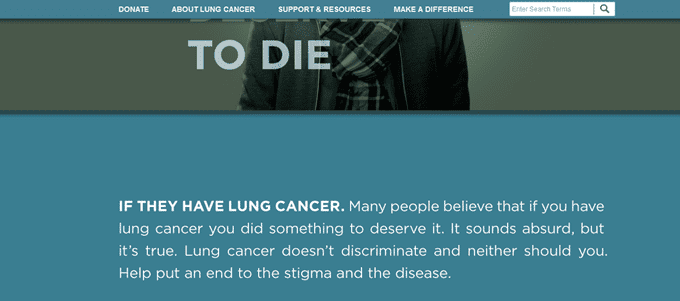
In my opinion, this is perfection. This web copy grabs the visitors attention, retains it and teaches the visitors about the dangers of lung cancer. At the bottom of the page ( by then you have invested enough attention and time already) you get to see this: the actual request.

Acknowledging and addressing the resistance
People don’t like to be told what to do. The art of persuasion might sound like a big bad manipulative project to them.
The best way to get them to do something is to make them believe you care for them and they can refuse anytime. Depending on your audience, there might be lists of objections of various sizes. Once you address their concerns, gaining compliance gets easier.
Buzzsumo figured, their audience feels uneasy to give away their payment details for a trial. To address that Buzzsumo offers “no credit card trial”.

This no string attached trial plan increases sign-ups for free trial as well as paid plans.
Conclusion
When it comes to persuading others compliance gaining techniques gives you a leg up. Now you have 8 different ways to subtly influence your audience and get more sign-ups, earn more revenue. There are many persuasion principles are out there. Do you use any of those? Let us know in the comments.

